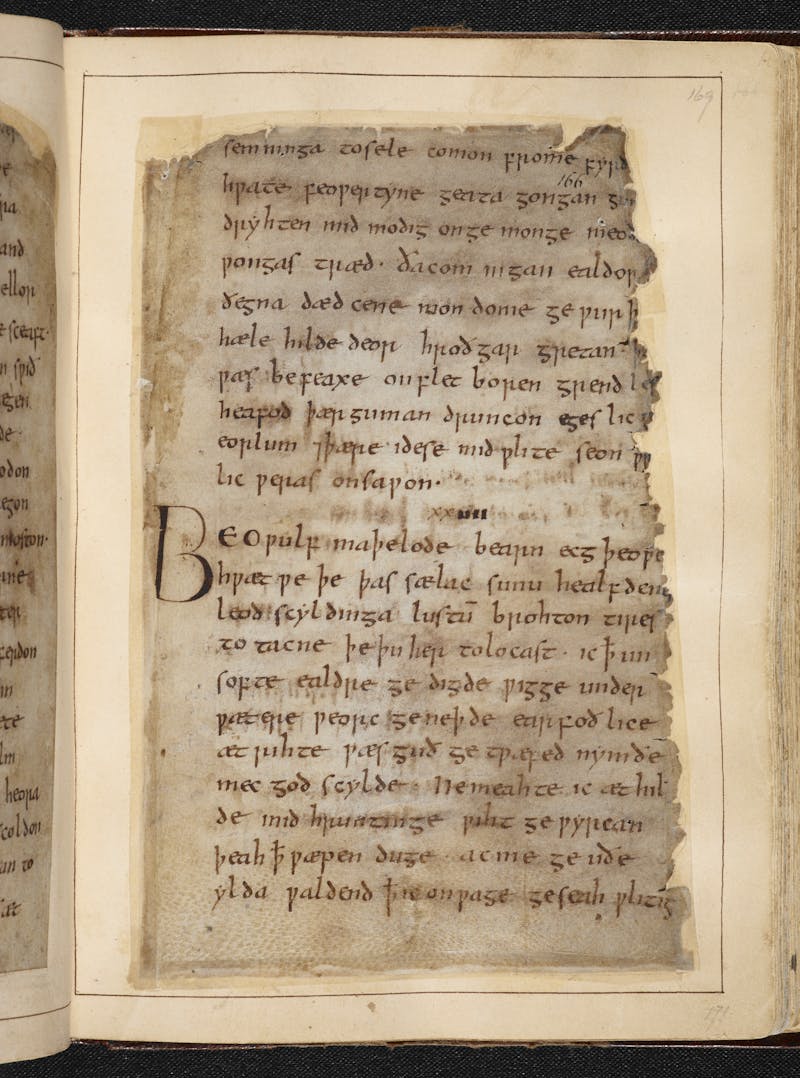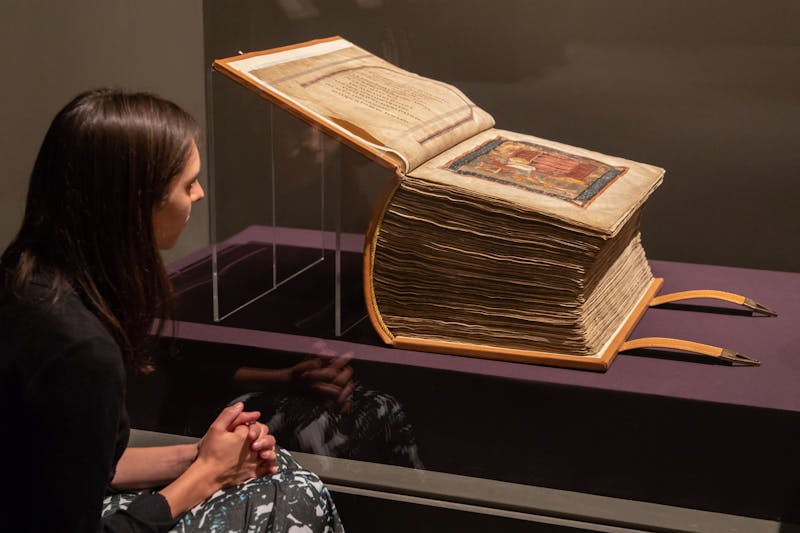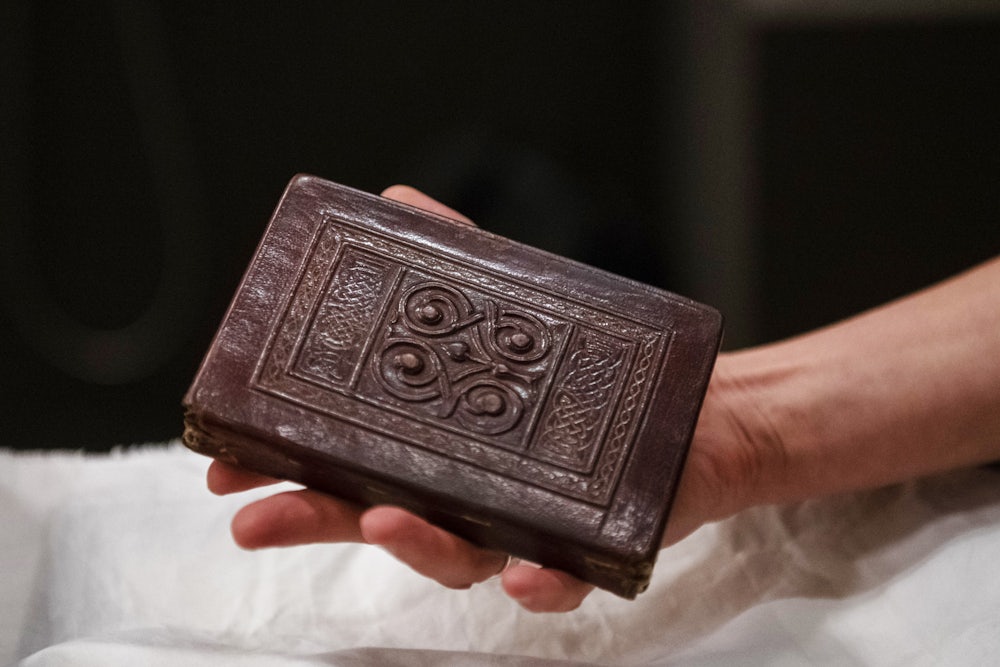There are four original manuscripts containing poetry in Old English—the now-defunct language of the medieval Anglo-Saxons—that have survived to the present day. No more, no less. They are: the Vercelli Book, which contains six poems, including the hallucinatory “Dream of the Rood”; the Junius Manuscript, which comprises four long religious poems; the Exeter Book, crammed with riddles and elegies; and the Beowulf Manuscript, whose name says it all. There is no way of knowing how many more poetic codices (the special term for these books) might have existed once upon a time, but have since been destroyed.
Until last week, I had seen two of these manuscripts in person and turned the pages of one. But then I visited “Anglo-Saxon Kingdoms: Art, Word, War,” a new show of artifacts at the British Library in London. It’s a vast exhibition, covering the art, literature, and history of the people whose kingdoms spread across Britain between the sixth and the eleventh centuries. The impetus for the show came from the library’s 2012 acquisition of the St Cuthbert Gospel, the “earliest intact European book,” in the words of the show’s catalog.

Seeing the earliest European book alone would be the event of a lifetime, for a certain kind of museum-goer. But for this viewer, the main attraction lay in a quiet little vitrine: all four Old English poetic codices, side by side. They don’t look that impressive to the casual eye. The exhibition room is dark and cold, to keep the books safe from damage. The manuscripts are brown, small, almost self-effacing. There’s no outward sign of how important they are, how unprecedented their meeting.
So why are these four books so special? It has to do, I think, with the concept of the original—a concept we have almost entirely lost touch with. The Beowulf Manuscript is not just composed of words that serve as the basis for every translation of the epic poem. It’s foremost an object, the only one of its kind. It is not merely a representation of a story; it is the story. In this respect, the manuscript resembles the Crown Jewels more than any document written in today’s world, any word that moves through the crazy fractal of the internet. The manuscripts confront us with a former version of our literary selves; identities that we barely recognize, and which estrange us from ourselves.
Each of the poetic codices has a specific history engraved into the text’s physical form. The very space they occupy on earth is meaningful. The Vercelli Book is named for Vercelli, a town in Northern Italy whose cathedral library holds the manuscript. Nobody knows for sure how the book got there, although the prevailing theory is that a pilgrim left it behind or gave it away on his travels. Who? Why? When? Unknown.
The Beowulf Manuscript’s permanent home is the British Library. Unlike Vercelli, we know exactly why it’s there. The manuscript’s pages have been remounted onto new ones, because the book was singed around the edges in a library fire in 1731. The fire consumed much of the collection of Robert Cotton—his unburned books were later all given to the British Museum, forming its foundational collection—but Beowulf only suffered a little. (The original Cotton collection was kept, with a horrible kind of accuracy, in a building called Ashburnham House.)
If we compare the Vercelli Book to the Beowulf Manuscript, we see different kinds of mysteries. The Vercelli Book is in fabulous condition, its English lines neatly written and sitting, inexplicably, in a region of Italy famous for its rice. The Beowulf Manuscript is a half-burned thing whose survival is a miracle. Its provenance is unknown: It was probably written down in the tenth or eleventh centuries, but it’s impossible to tell when it was actually composed.
Where did the fire come from? Where did the poetry come from? We do not know the identity of the authors of any Old English poems, any more than we know where the first spark flew. Why are these the manuscripts that have survived, and what wandering spirit has guarded them down the centuries? The mysteries start to pile up into a mountain, intimidating in its inaccessibility.
Our current relationship to the written word could not be more different. We remain in the age of mechanical reproduction, the name famously given by the theorist Walter Benjamin to the way that works are replicated via photography, the printing press, and film. In his 1936 essay on the subject, Benjamin wrote, “Even the most perfect reproduction of a work of art is lacking in one element: its presence in time and space, its unique existence at the place where it happens to be.”
Our concept of authenticity is derived from the “presence of the original,” he writes, such as “proof that a given manuscript of the Middle Ages stems from an archive of the fifteenth century.” Without such proof, an original becomes a forgery. But when we reproduce a work (via a photocopy or an ebook, say), we create not a forgery but something new. We can “put the copy of the original into situations which would be out of reach for the original itself”—the manuscript can leave the cathedral and enter our own homes.
Benjamin argued that this process of reproduction inevitably diminishes the artwork’s presence. He calls that quality an aura: “that which withers in the age of mechanical reproduction is the aura of the work of art.” That withering kills our connection to tradition, to the ineffable magic of the original, and—in short—to the entire history of how humans once related to art.
In 2018, we are in a much more elaborate and abstracted phase of Benjamin’s reproduction theory. We are accustomed to reading without reference to any physical object specific to the act of reading. We might have a romantic association with libraries, or prefer to turn real pages rather than electronic ones, but those are tastes borne of nostalgia. They have no real meaning for our experience of literature’s power.
This is why the reunion of the Old English poetic codices is so overwhelming. We have no mental equipment—or, at best, a very rusty apparatus—to process the existence of a physical original. Even our encounters with paintings in a museum are ultimately filtered through mass media and the devices with which we read the written word. It is difficult even to summon in our minds the circumstances of Benjamin’s 1936 essay; the technology has simply moved too quickly.
If we are that disconnected from 1936, but the Old English poetic codices predate Benjamin by an entire millennium, then it is no wonder that being confronted by these manuscripts leads to a feeling of numbed, startled astonishment. I’ve spent years dreaming of these books, but when all five of us finally met I couldn’t do anything but cry. I thought I knew them, through digital replicas. These books should have been a mirror, some kind of catalyst to self-recognition. But when I looked at them I saw nothing. I only saw the yawning void of everything in human history that I cannot understand, everything that has been taken from our culture by the incredible acceleration of technology over the course of my lifetime.

There are too many miracles to count inside the British Library’s exhibition. You can see the Codex Amiatinus, the earliest surviving complete Christian Bible in Latin. It’s enormous, weighing over 75 pounds. Here you will see the Domesday Book, the earliest public record in existence. Here is the River Erne horn, an eighth-century trumpet found in the waters of its name in the 1950s. Here is gold from the sixth century.
But as I walked out of this dazzling exhibition, I also realized the miracle that is the survival of Old English itself. If all we share with the Anglo-Saxon literature is language, then that is a remarkable consolation. The words are difficult to understand, but—miracle of miracles—we can translate them all.
Historians might care more about the singeing of the Beowulf Manuscript, the unknown pilgrim who walked through Italy. For the student of literature, however, Beowulf’s existence on the internet is as startling as the single book sitting by its sisters in a London library. If the book burned today, then the poem would still survive. The new permanence that reproduction gives us is the hope contained in Benjamin’s dirge. But it might be worth putting a replica in a bunker, just in case.
